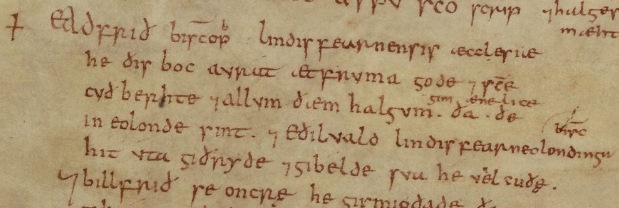Script Type : minuscule
Date : This example is from the 10th century, although the script was used until the 12th century for Old English writings, and much longer in Ireland.
Location : England, in this case from Lindisfarne
Function : book hand

























Distinctive letters : As can be seen now that we have a colour photograph, the colophon is is rubric.
This form of insular minuscule used for Old English has essentially the same letter forms as that used for Latin, with the addition of both the edh and thorn characters to represent th. This example lacks the letters k, q, w, x or z. The letter j only appears in a Latin name.
The letter a comes in two forms, closed at the top and open. Ascenders of letters such as b and l are wedged at the top. The letters r, s and f are easily confused, as all tend to extend below the baseline and are similar in general shape. The letter d has a backsloping ascender, while g is of the open lightning bolt form. While the letters u and v are diffentiated, in that there is a rounded and an angular form, the angular form seems to be used in most cases as either vowel or consonant.
The
trickiest ligature
is the dipthong ![]() ae, which is written as an e with a little hook on the back.
ae, which is written as an e with a little hook on the back.
The
Tironian
et character ![]() appears as an abbreviation for and.
appears as an abbreviation for and.
Pass the cursor over the first few lines for a quick transcript. To examine this text in more detail, and to find out what it all means, proceed to the paleography exercises.
Paleography
exercises for this example using Flash ![]()
Requires at least the Flash 5 plugin
If you are looking at this page without frames, there is more information about medieval writing to be found by going to the home page (framed) or the site map (no frames).